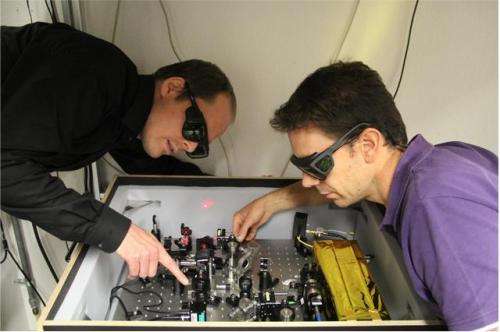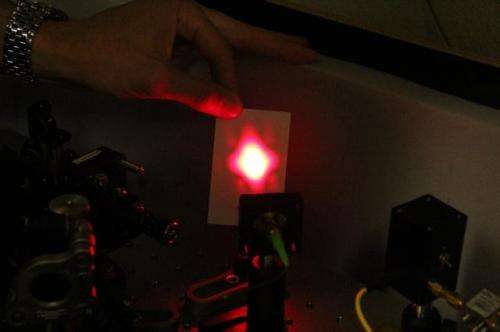New optical frequency comb has record low laser relative intensity noise

An optical frequency comb that has record low laser relative intensity noise and in which the carrier envelope offset frequency has been stabilised to very low level, has been demonstrated by researchers at Centre Suisse d'Electronique et de Microtechnique (CSEM) in Switzerland.
This system, which is simple, stable and based on commercial components, already satisfies many of the demands for real-world use, and could increase the performance and range of applications, including ultra-precise distance measurements, and rapid, high-resolution molecular spectroscopy.
High precision
An optical frequency comb is a light source with equally spaced discrete spectral lines, which can be seen as the teeth of a comb. They are used as the 'gear box' between the optical and microwave frequency domains and have, for example, increased the precision and stability of atomic clocks by orders of magnitude. The ultra-low phase noise generation of radiofrequency and microwave signals is also possible, with application in radar, imaging systems and scientific facility synchronisation.
Most frequency combs are realised using mode-locked femtosecond lasers in which many laser lines are present, with an equal spacing determined by the repetition rate of the laser. An offset of the comb is also present and is related to the phase between the maximum of the pulse envelope and the light electrical field: the carrier-envelope offset frequency. For precision and metrological applications, the frequency comb produced by the laser has to be fully stabilised in terms of its pulse repetition rate and offset frequency.

System engineering
The researchers from the Time and Frequency Section at CSEM are interested in different kinds of time and frequency sources including miniature atomic clocks, semiconductor lasers and optoelectronic oscillators. They are developing these for real-world applications such as those mentioned previously in an industrial environment, or even in space such as in the improvement of instruments for the search of exoplanets.
In their Letter in this issue, the team from CSEM used well-known approaches for the realisation of their frequency comb, but approached it as a system. The choice of the laser, which is the heart of the frequency comb system, was crucial.
"We decided to employ an industrial grade femtosecond mode locked laser from Onefive GmbH because of its low noise, high stability and high reliability," said Dr Steve Lecomte, the Section Head at CSEM. "Actually, the laser does not require any adjustments or maintenance and is thus the base for the reliability of the whole system. Parts of the stabilisation electronics and the laser current source were developed in-house, making use of the different disciplines present at CSEM, spanning from physicists to electrical and mechanical engineers."
The laser generates a 100-MHz pulse train at a centre wavelength of 1047 nm. The researchers carefully optimised all parts of the system – namely the electronics and the optical system – and achieved stabilisation of the carrier-envelope offset frequency to a record-level, contributing to relative fluctuations of the optical carrier frequency at the 10 −18 level at 1 second.
The performance of their frequency comb is an order of magnitude better than typical Ti:Sa based systems, and 2–3 orders of magnitude better than systems using lasers with similar pulse duration and repetition rate.
Increased stability
The ultra-low noise optical frequency comb has shown itself to be reliable as it can routinely run with this level of stability for ten hours. Although the system already meets many of the requirements for the demanding real-world applications, the team will be looking to make further improvements such as making the optical setup more compact and mechanically stable, and industrialising the electronics system.
"Since the beginning of this development we have started also stabilising frequency combs at other wavelengths and also to stabilise cw lasers on high-finesse ultra-stable optical cavities," said Lecomte. "The idea of this activity is the combination of stabilised cw and pulsed lasers to get a completely stabilised frequency comb referenced to an ultra-stable optical reference. This will allow the generation of ultra-low phase noise microwave signals, ultra-precise spectroscopy and distance measurement."
More information: "Ultra-low-noise 1 µm optical frequency comb." S. Kundermann, et al. Electronics Letters, Volume 50, Issue 17, 14 August 2014, p. 1231 – 1232. DOI: 10.1049/el.2014.1496 , Print ISSN 0013-5194, Online ISSN 1350-911X
Journal information: Electronics Letters
Provided by Institution of Engineering and Technology
This story is published courtesy of Electronics Letters. For additional Electronics Letters news and features visit theiet.org/eletters.



















